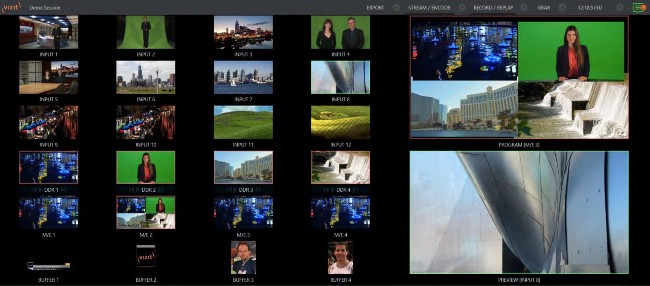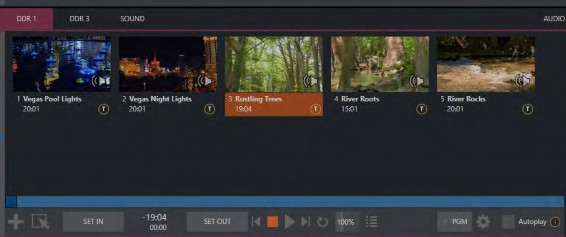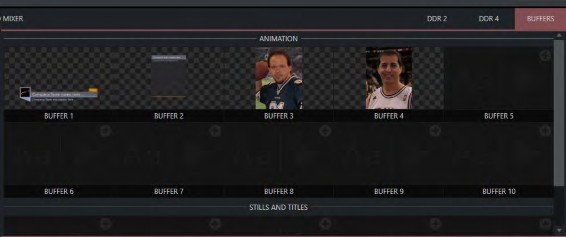
Viz Vectar User Guide
Version 1.0 | Published May 07, 2020 ©
Features
Let’s take time for a brief overview of just some of the key features of your system:
Physical
-
Handsome, and rugged 3RU rack-mountable chassis.
-
Easily accessible audio and video, monitoring and network connectors on the backplane for convenient installation in industry standard mounting.
Multi-Tier Failsafe
Always on Air features provide multi-tiered redundant failsafe mechanisms in both hardware and software. Let’s list just a few, below.
-
Multiple software failsafe systems continually monitor and safeguard the live performance. Any recoverable software error conditions are quickly and unobtrusively dealt with.
-
Video pass-through ensures that as long there is AC power, audio and video from the highest numbered local hardware input are routed to Output 1 in a case of catastrophic software condition.
-
If at all possible, streaming output and recording also continue even if all else fails.
-
Your live production system also has a comprehensive integrated system restore feature. You can quickly reset the system to factory defaults, or create and use custom drive images on external volumes to restore the system.
-
If a control surface connection should be interrupted, the system attempts to reconnect automatically without user intervention.
A/V Input and Output
It’s worth taking a moment to consider that each NDI (network) output potentially replaces multiple traditional output connections.
For example – it is not unusual to need multiple physical outputs from a traditional video switcher for a single source – one for recording, another to broadcast, still more for local monitoring, and so on, with each destination consuming precious hardware connections. This is not the case with NDI- enabled production systems, which allows multiple downstream connections to a single network output.
Thus, it requires no hyperbole to state that Viz Vectar provides virtually unlimited outputs, without additional hardware. And if you do require more standard SDI outputs than the four provided, the system is easily extended using any number of rack-mountable NDI output modules.
Other features include:
-
Live switch up to 44 external video sources, and nearly as many internal sources.
-
SDI video input and output, internal and network video sources, and analog audio input and output.
-
Connect popular SDI video routers to further extend input options.
-
Control supported PTZ cameras via NDI (or other common IP control protocol) or *serial connection. *requires USB-serial adapter.
-
Freely mix multiple video formats, and output UHD and HD sessions simultaneously.
-
Supply Microsoft Windows® or Apple Macintosh® computer displays as Switcher inputs over the network using NDI® Scan Converter clients.
-
Update Buffers in watch folders from networked graphic workstations, even during live production.
-
Transmit output to other NDI-enabled systems across the network.
-
Create complex M/E effects and compositions using multiple sources with live (virtual) camera moves.
-
Cascade effects in endless creative ways using multiple re-entrant M/Es.
-
Use switcher row color groups to link video sources for multiple M/E s, etc.
-
Mix internal and external audio sources, including analog or SDI Embedded audio.
-
Multiple video outputs, including streaming, can individually supply unique video formats; designate output mixes or individual sources for output in various formats up to 2160/59.94P (and also a selection of non-standard aspect formats).
-
Send Main or AUX bus audio mixes to a variety of physical and IP audio outputs.
Timecode
-
NDI Quicktime® recording format includes embedded time-code.
-
Recorded clips are easily aligned for synchronized post-show editing using timecode.
Monitoring

-
The Live Desktop includes a large monitoring pane with multiple, easily customized Workspaces.
-
This multiview allows you to keep an eye on all live and internal video sources, including Media Players and both local hardware and network sources.
-
External Multiview Workspaces offer many alternatives, including numerous multi-bridge layouts, overlays and Event Clocks.
-
Monitor sources on both Live Desktop and external Multiviews are user-configurable, and include Media Player clip timecode counters, and custom logo display.
-
Waveform and Vectorscope monitors help you calibrate your signal to ensure your output meets broadcast standards and looks great.
Video Processing
-
Full 4:4:4:4 32-bit floating point internal processing of all video sources.
-
Proc Amps and White Balance controls for every source preserve pristine image and color fidelity.
The Switcher
The powerful Switcher module, which provides native support for the popular NDI® (Network Device Interface) protocol, puts your sources at your fingertips in a familiar Program/Preview row control layout.

For less complex productions, the Switcher’s convenient Express mode simplifies the process (). This one-button operating mode is especially welcome in environments where volunteers or less experienced operators are involved.

Additionally, optional support for switching with a touchscreen has been provided. See something interesting on a viewport in the monitoring section? Just tap the corresponding viewport to instantly send that source to Program output, using the current background transition.
Video Layers and Transitions
The Transition section of the Live Desktop provides powerful tools for arranging and displaying the numerous video and graphic layers contributing to your ultimate program output.

-
Freely hot-punch or transition between external sources, internal Media Players, and M/E effects.
-
Latch selected Switcher and M/E source rows in color groups to synchronize switching operations.
-
Multiple DSK (Downstream Key) Switcher channels and independent KEY channels for each M/E, permit endless creative possibilities.
-
DSK and KEY sources are represented by small full motion confidence monitors.
-
Use any of the hundreds of transitions supplied to reveal either Background or DSK/Key channels with animated wipes, trajectories and dissolves, including colorful Animation Store transitions with sound effects.
-
Reveal combinations of video layers with one operation of the T-bar or click on Take/Auto buttons.
-
Or use per-layer controls to independently display any layer with or without transitions.
-
Employ Speed, Reverse and Ping Pong options to modify individual transition effects for any layer.
DSK Channels

-
DSK layers support downstream overlays (M/E Keys are upstream overlays, i.e., ahead of the main Switcher).
-
Display DSK channels independently and swap them during a switch with custom transitions.
-
Assign Media Players, Buffers or camera feed or network source to an overlay channel.
-
Independent Crop, Position, 3D Rotation, and Scale controls for each DSK channel permit you to configure multiple sources as picture-in-picture elements and reveal them with custom effects.
M/Es

Color-coded M/E (Mix/Effect) banks provide stunning effects.
These include secondary video mixing capabilities, switching with traditional wipes, full alpha channel support and real-time keying technology for green/blue screen effects, and much more. Each M/E bank supports:
-
Up to four primary video sources per effect.
-
Four KEY (overlay) channels with individual transition capabilities.
-
Sub-mix functionality, with individual transitions for A/B Background layers and all KEY channels.
-
Individual Scale, Position, Crop and Rotation controls and motion Tracker support for all channels.
-
Powerful Comp (composition) preset features let you animate layer and overlay position, rotation and other attributes.
-
Convenient MEM system allows instant access to pre-configured M/E setups.
Record and Stream
-
Record live-switched production at full resolution to a high-quality QuickTime® format.
-
Captured files include embedded timecode.
-
Capture technology supports multiple simultaneous a/v recordings chosen from among local hardware camera inputs and the four primary outputs.
-
Easily grab still images from any Switcher source, or batch capture selected outputs.
-
Simultaneous output for broadcast, projector and web stream to in-house and remote audiences.
-
Live stream live to multiple destinations for redistribution and archive your stream locally.
Media Export
Integrated Export support makes it easy to distribute content to multiple targets. Export even stores credentials for social media and upload sites and provides a queue for batch file transcoding and upload.
Clips and stills from live sessions can be added to the Export queue without interrupting production, for distribution to multiple hosting services and social media sites (including Twitter®, Facebook®, YouTube®, and more) – even when live production recording is still underway. This is great for concerts, galas, sport events, game shows and more. The Export feature directly addresses FTP sites and network locations too. Transfer media to multiple locations at the same time to meet post-production needs or other collaborative and archival requirements.
Automation
Record, edit, and play back macros, whether a simple operation or more involved series of events at the touch of a button. Use powerful integrated automation systems to trigger these, simplifying complex tasks and ensuring consistent operations.
Hotspots, Triggers and Trackers
Define multiple onscreen Hotspots for different (chromakeyed) sources, and trigger macros automatically whenever something opaque enters the hotspot. This live interactivity opens up countless creative applications.
Trackers provide motion data from selected color regions as they move about the frame in real- time. Lock video sources to Tracker output using Position tools in M/Es banks and DSKs and they follow obediently.
Import
The integrated Import Media feature provides a convenient one-stop approach to gathering productions assets.
-
Batch import media files for use in Media Players.
-
Imported files can be pre-assigned automatically to specific players, making them easy to find and use during live productions.
-
When necessary, imported files are transcoded.
Audio Mixer
The integrated Audio Mixer provides extensive multi-channel control and management.
-
Adjust numerous internal and external audio sources, and introduce them into your program manually or automatically.
-
Control output levels for program, headphones, auxiliary outputs, recorders, and stream separately.
-
Convenient Audio Mixer MEM system allows single-click access to prepared setups.
-
Automation allows complex video follow audio options and threshold macros.
-
Exclusive or latched Solo controls.
-
Independent 7-band EQ, Compressor/Limiter and Noise Gate for each source and output.
-
Complete multi-bus 8x8 matrix routing options.
-
Configurable VU meters: Show calibration on digital (dBFS) or analog (dBVU or dBu) scales.
Integrated Media Players
Media Players and the title system serve up graphics and audio files quickly and easily.

-
Add sound or still images to Media Player playlists.
-
Re-order playlist entries.
-
Add colorful transitions between playlist items.
-
The Sound module has volume and other advanced audio controls in the Audio Mixer.
-
Convenient per entry audio level control.
-
Autoplay feature starts and stops playback automatically based on Switcher activity.
-
Control Media Players with macros triggered by other events.
-
Assign titles, graphics, or buffers to multiple DSK or M/E Key channels.
-
Instantly transition media to the Main Switcher or an M/E and then restore the original source using the Show On feature.
-
Store playlists and player configurations in MEM slots for easy recall.
Buffers
The Buffers module provides quick review and management of the internal media buffer system, providing combined playback and asset management tools, and is fully supported by the Macro system.

Buffers can be applied in any video channel, including all main Switcher and M/E rows, or as overlays in the countless DSK/KEY channels. Buffer slots can contain animated effects, still graphics or editable title pages.
Buffer effects are resident in reserved Switcher Memory, making it possible to use them all at once without tying up Media Players.
Optional Control Surfaces
Several optional control surface options have been designed to complement your system, making your live production operations even more convenient. Once you get your hands on one, you’ll never want to let go.
In summary, this live production system gives you more combined production power than any other single broadcast appliance. Let’s jump in now. First, we’ll get you connected, and then we’ll explore some of the system’s foremost features.